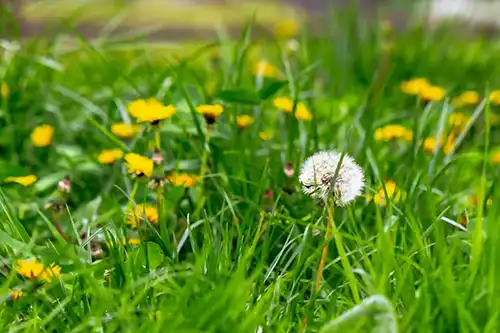What Types of Weeds Are Common in Florida?
Identifying a weed or invasive species early on can help you treat the problem before it can spread across your property. Some of the most common weeds in Florida include:
- Artillery weed: This pesky weed that often takes over gardens and lawns. Its small, oval-shaped leaves give it a distinctive appearance. What sets it apart is its ability to “shoot” its seeds several feet when touched, hence the name. Be cautious when handling artillery weed to prevent it from spreading. It typically thrives in warm weather and can be found throughout the year in mild climates.
- Crabgrass: It’s recognized by its low-growing, broad leaves that often sprawl in a circular pattern. This weed is notorious for outcompeting desirable grasses and can be identified by its distinctive seed heads in summer. To control crabgrass, consider using pre-emergent herbicides in the spring to prevent it from taking over your lawn.
- Spanish needles: This is a common weed with fine, feathery leaves and small, yellow flowers that resemble daisies. This weed can be found in many types of soil, often growing in disturbed areas. It’s known for its barbed seeds that can cling to clothing and fur, making it a nuisance in gardens and fields. Spanish Needles tend to bloom from late spring to early fall.
- Spurge: Spurge is a broad category of weeds that includes various species. They are typically low-growing with distinctive, fleshy leaves and a milky sap that can be irritating to the skin. The leaves vary in shape among different species, but they often have a circular arrangement on the stem. Some spurge varieties can produce inconspicuous flowers.
- Kylinga: This is a grassy weed with triangular stems and small, inconspicuous flowers. It’s often mistaken for a grass due to its similar appearance but can be identified by its three-ranked leaves and the presence of tubers or nutlets at its base. Kylinga typically grows in wet or damp areas, such as around ponds, and is prevalent during the summer months.
- Dove weed: Dove Weed gets its name from the belief that mourning doves use it for nesting material. It tends to thrive in sunny locations and can be found throughout the summer. You can identify it by looking for the distinctive oval-shaped leaves with spots and small green flowers.
- Wood sorrel: Also known as ‘Oxalis,’ this is a common weed characterized by its clover-like leaves and delicate, five-petaled flowers that come in various colors, including yellow and pink. Unlike true clover, wood sorrel has heart-shaped leaflets. It often pops up in lawns, gardens, and other disturbed areas. Wood Sorrel is known for its sour-tasting leaves, which are edible in small quantities.

Need Lawn Care? We Can Help.
Click the button below to leave your information & we'll be in touch in an hour or less.
Pest Control Experts You Can Trust
Leave your information below and we’ll be in touch with your FREE quote!
"*" indicates required fields
*During normal business hours. After hours inquiries will be returned the next business day.
How to Get Rid of Weeds
When dealing with weeds, it’s best to seek professional assistance sooner rather than later. Invasive plants can rapidly take over your garden, causing significant harm to your other plants. Since each type of weed is unique, there’s no one-size-fits-all solution for treatment. Professionals can swiftly and effectively eradicate the weeds and design custom treatment plans to prevent their return, tailored to your specific situation.
